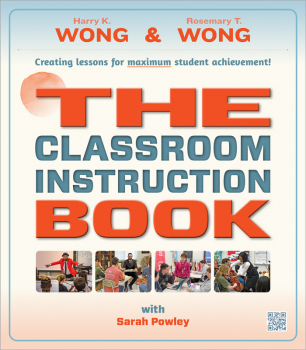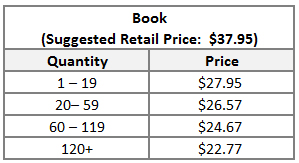THE Classroom Instruction Book

THE Classroom Instruction Book
This books offers a clear path for closing the achievement gap for all students. Learn the instructional strategies that produce results. Create and organize instruction so student success is assured no matter their demographics or circumstances.
Suggested Retail Price: $37.95
Paperback
Publisher-Direct Price: $27.95
click here
-
Overview
Instruction. It’s what teachers were hired to do—teach! This book takes decades of research on how to teach effectively and shows in detail how to put it into practice in the classroom with lesson planning, instruction, assessment, and evaluation. The content covers K-12 grade levels and all subject areas. Detailed examples, illustrations, photos, and templates are shown in the full-color book.
This is a companion book to THE First Days of School. It takes one of the three characteristics of effective teaching—lesson mastery—and covers the topic in depth showing how to implement it consistently to produce results for ALL students.
Fifty QR codes are scattered throughout the book to extend the learning.
- 304-page book with Index and Bibliography
- 50 QR codes of additional resources
- ISBN: 978-0-9963350-9-6
-
Table of Contents
THE Classroom Instruction Book
ContentsDedication
Introduction
ImpactUnit A: Learning and Achievement
1 How to Ensure Effective Instruction
2 How to Teach for Student Achievement
3 How to Organize Instruction
Unit B: Objectives
4 How to Use Objectives
5 How to Use Learning Targets
6 How to Use Essential Questions
7 How to Drive Instruction Using Objectives
Unit C: Assessment
8 How to Use Assessment
9 How to Use Feedback
10 How to Use Personal Assessment
11 How to Use Group and Partner Assessment
12 How to Use Rubrics
13 How to Teach Self-Assessment
Unit D: Instructional Strategies
14 How to Create and Use a Lesson Plan
15 How to Deliver the Instruction
16 How to Use Instructional Strategies
17 How to Use Guided Practice
18 How to Use Independent Practice
19 How to Use Evaluation
Unit E: Implementation
20 How to Use Teacher Clarity
21 How to Teach with Collaboration
22 How to Teach with Impact
QR Code Summary
Bibliography
Index
Authors
Acknowledgments
Implementing THE Classroom Instruction Book -
QR Codes

This information corresponds to the QR code information offered in THE Classroom Instruction Book. Each code provides additional information, research, templates, or activities that supplement the book.
Click each title to access the content.
Unit A: Learning and Achievement
1 Research on Effective Teaching
Scan the QR code for the complete citations for these studies. Additionally, access this information and all QR code files at www.EffectiveTeaching.com on the QR code tab for THE Classroom Instruction Book.2 Binder Covers
Download covers for your Classroom Instruction Plan binder.3 Ranking of Effect Sizes
See John Hattie’s complete list of influences on student achievement.4 Effect Size
Read more information on effect size and the statistical implications for learning.5 Rising to the Top
See the list of countries and how to move to the top of the list.6 Don't Teach in Panic Mode
See if you're teaching in panic mode and how to get out of it!Unit B: Objectives
7 Bloom's Taxonomy
Access the code to see Bloom's Taxonomy.8 For the Love of a Closing Couplet
If you are curious, scan the code to see a correct response for the Shakespearean sonnet objective.9 From Paragraphs to Essay
See an example of how a student can convert paragraphs into an essay, bit-bybit and step-by-step.10 WALT and WILF
Use these and other ready-made WALT and WILF graphics to bring clarity to your instruction.11 Note This Essential Question
See an example of how a single essential question can be utilized in a year-long general music class.12 Sources for Essential Questions
See this listing of websites for additional essential questions.13 How to Design an Efficient and Effective Emergency Room
This blog essay is a great example of Career and Technical Education where high school students work in teams.14 Study Guidelines Define Lesson Objectives
See an example of a study guide or find it in THE First Days of School on page 240.Unit C: Assessment
15 Outperform 98 Percent of Regular Students
Read and learn from studies that show that assessment for learning is comparable to individual tutoring in its effectiveness.16 Corrective Feedback
See how English language learners struggle with corrective feedback.17 3.2.1.
This tool collects specific, detailed information about what students understand to be the most important information about a topic.18 Concept Map
This tool visualizes information so students can connect ideas, concepts, and terms.19 Entry Ticket
This tool gathers information regarding previous learning and may help to prescribe changes for the day’s lesson.20 Graphic Organizers
This tool organizes and structures information to be readily recalled by students.21 K-W-L
This tool assesses what students already Know, what they Want to know, and what they have Learned.22 One-Minute Note
This tool encourages students to form a concise summary of what they just learned at various points in the lesson.23 Stop and Jot
This tool gives students the opportunity to record their perception of a key concept or idea about a lesson topic while it is still fresh in their minds.24 Study Cards
This tool creates personal note cards to use for study and review.25 Triangle-Square-Circle
This tools accesses information that students feel is important, they agree with, or is still circling in their minds.26 Back and Forth
This tool engages students in activities where they share ideas and discuss how each perceives the new information.27 Buddy Journal
This tool pairs students and engages them in a back-and-forth written discussion about their writing and strategies to improve upon it.28 Card Sort
This tool engages students in activities of sorting and categorizing to help them analyze similarities and differences among concepts.29 Quiz, Quiz, Trade
This tool allows students to assess the knowledge of their classmates in an engaging quiz-game format.30 Tableau
This tool asks students to physically manifest their understanding of a question or concept.31 Rubrics on the Internet
No need to reinvent the wheel. The Internet is awash with websites for creating rubrics at all grade levels and all content areas.32 Rubrics in This Chapter
The full version of all of the rubrics shared in this chapter are here for you to use or adapt to your curriculum needs.33 Gaming Challenge
Read more about the challenge of computer gaming.34 Argumentative Paragraph Structure Rubric
Download the full rubric to use with your students.Unit D: Instructional Strategies
35 Setting Standards
View the list of professional organizations to access their set of standards.36 Lesson Plan Template
Download this lesson plan and Karen Whitney’s lesson plan template to use as a guide when planning your instruction.37 Middle and High School Lesson Plans
Access examples of completed lesson plans for middle and high school.38 Consistency
See what Sisseton Middle School does to establish consistency in classroom management39 A Sample Elementary Lesson Plan
See how Amanda Bivens of Dyersburg, Tennessee, creates a lesson on abolitionist leaders.40 Kansas Teacher Examples
Karen Rogersshows how to use spaced learning and interleaving.41 Strategies for Instruction
Read an article about the ten, research-based strategies for instruction.42 Role Cards
Use these role cards to help students with the responsibilities of the Predictor, Questioner, Clarifier, and Summarizer.43 Reciprocal Teaching
Kentucky teacherJeff Gulle reports how he uses reciprocal teaching in his history lesson.44 Extending the Learning
See how a teacher uses the food chain to extend students’ learning beyond independent practice.45 Independent Study Rubric
Download Oretha Ferguson's The Power of Voice rubric to use with your students.46 Limitless Possibilities Through Structure
Learn how Laurie Kash organizes her class to bring out the potential creativity of all her students.Unit E: Implementation
47 Ants
Ants. What are they busy about?48 Katie's Outcome
Find out what happens to Katie by scanning the QR code.49 Lesson Study Process
Read the process that Shota Matsumoto and his colleagues engage in as they go through the details of a lesson.50 Implementation Guide
Scan the QR code for a free, in-depth Professional Development Implementation Guide for THE Classroom Instruction Book
or download at www.EffectiveTeaching.com. -
Preview
-
Professor Copies
We are pleased to provide copies of our books to qualifying professors with the submission of a request form.
Desk Copies
Desk copies are complimentary copies sent to professors who have adopted our books for their course. We provide one complimentary desk copy with an expected enrollment of 10 or more students in your course. Expected enrollment will be verified through your bookstore. Desk copies are limited to one per professor every two years.
Preview Copies
For professors considering the use of any of our books, we provide an electronic preview copy for a 60-day access period through Vital Source Bookshelf.
For professors wishing a hard copy for preview, we require a refundable deposit of $19.95 (plus sales tax for California orders only). The amount will be refunded in full upon the return of the preview copy or adoption of the book with qualification for a complimentary desk copy.
Professional Copies
For professors who would like a personal copy of our books but do not qualify for a complimentary desk copy, books are available at a professional discount of $19.95 (plus sales tax for California orders only). There is a limit of two professional copies per instructor.
Professional Copy Request Form
For additional assistance with your desk, examination, or professional copy, please call 650-965-7896 or email [email protected].
-
Volume Pricing
We are pleased to offer a savings for quantity orders of THE Classroom Instruction Book.

Click here to download a complete list of our products and the volume pricing we offer.
